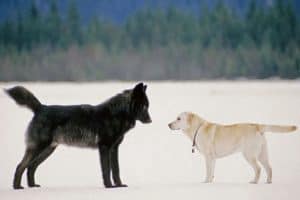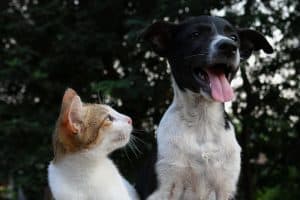Cats and dogs have very different personalities, with one noticeable distinction being their vocalization habits. Cats are notably quieter than dogs for a variety of reasons. Let’s delve into why cats are more quiet than dogs.
Evolutionary Factors
Cats and dogs have evolved very differently over the years, and these evolutionary factors play a significant role in their vocalization tendencies. Cats are descendants of solitary hunters, so they have adapted to be more stealthy and quiet to sneak up on their prey without alerting them. On the other hand, dogs descended from pack animals, where communication through barking was crucial for coordinating hunts and protecting their territory. This evolutionary history has wired cats to be more reserved and less vocal compared to their canine counterparts.
Communication Styles
When it comes to communication, cats and dogs have distinct ways of expressing themselves. Cats tend to be more independent and subtle in their vocalizations, using purrs, meows, and chirps to communicate with humans and other cats. These soft sounds are meant to convey their needs or emotions without being too disruptive. Dogs, on the other hand, are more expressive and vocal, using barks, growls, and whines to convey a wide range of emotions and messages. This difference in communication styles contributes to dogs being generally louder than cats.
Additional Insight: Cats are known to be masters of body language, using subtle cues like tail flicks and ear positions to communicate. This reliance on non-verbal communication may also be a reason why cats are quieter than dogs, as they have other effective means of getting their message across.
Hunting Strategies
Cats and dogs have distinct hunting strategies that influence their vocalizations. Cats are known for their stealthy approach to hunting, preferring to quietly stalk their prey before making a swift and silent attack. This natural instinct for silence carries over into their everyday behavior, making cats generally quieter than dogs. On the other hand, dogs tend to rely more on their pack mentality when hunting, communicating with each other through barks and howls to coordinate their movements. This social hunting style contributes to dogs being more vocal creatures overall, as they use their voices to communicate and coordinate effectively with their pack members.
Key Insight: Cats’ quiet nature during hunting extends beyond just their prey; it also affects their general behavior, making them quieter companions in our homes compared to dogs.
Socialization Differences
The social structures of cats and dogs greatly impact their vocalization habits. Cats are more solitary creatures by nature, often preferring to hunt alone and establish their territory without the need for extensive communication with others. This independent lifestyle translates to their vocalizations, with cats typically being quieter and using sounds like purring or meowing more sparingly. On the flip side, dogs are highly social animals that thrive on interacting with their pack members. This social nature leads to dogs being more vocal, using barks, growls, and whines to express their emotions, signal danger, or communicate with their human companions.
Key Insight: Dogs’ reliance on vocalization for social communication can sometimes result in more noise than necessary, compared to the more reserved nature of cats.
Additional Unique Insight: Cultural Factors
Besides hunting strategies and socialization, cultural factors can also play a role in the vocalization differences between cats and dogs. In some cultures, dogs may be more encouraged or conditioned to vocalize, leading to louder behaviors. Conversely, cats may be viewed as more independent and expected to be quieter, influencing their vocalization habits. This cultural influence adds another layer of complexity to the already distinct vocalization patterns of cats and dogs.
Remember, understanding these differences in hunting strategies, socialization, and even cultural factors can help us appreciate and better communicate with our feline and canine companions.
Breeds and Individual Variations
When it comes to the volume of our furry friends, cats tend to be quieter than dogs. But why is that? Well, let’s dive into the world of breeds and individual variations to shed some light on this topic.
Cat Breeds: Different cat breeds can vary in their vocalizations. For example, Siamese cats are known for being quite chatty, while breeds like the British Shorthair tend to be more reserved and quiet. So, if you’re looking for a quiet companion, you might want to consider a breed that is known for being less vocal.
Dog Breeds: On the other hand, some dog breeds are more prone to barking than others. Breeds like Beagles and Dachshunds are known for their loud voices, while breeds like Basenjis are considered relatively quiet. Knowing the typical vocal tendencies of different breeds can help you choose a pet that fits your noise tolerance.
Individual Variations: Just like people, each cat and dog has its own unique personality. Some cats are naturally more talkative, while others prefer to keep to themselves. Similarly, some dogs bark at the drop of a hat, while others are stoic and quiet. When choosing a pet, it’s essential to consider the individual traits of the animal rather than solely relying on breed stereotypes.
Understanding the nuances of different cat and dog breeds, as well as acknowledging the individual variations in personality, can help explain why cats are generally quieter than dogs.
Environmental Adaptations
Imagine being a stealthy predator, silently stalking your prey in the shadows. That’s the life of a cat! Their evolutionary history as ambush predators has shaped their behavior and ultimately led to their quieter nature compared to dogs.
Cats as Ambush Predators: Cats are skilled hunters that rely on stealth and surprise to catch their prey. Being quiet helps them sneak up on unsuspecting birds or mice without giving themselves away. This instinctual behavior has been ingrained in cats for thousands of years, making them naturally quiet creatures.
Dogs as Active Hunters: On the flip side, dogs have a history of hunting in packs where communication through barks and howls was essential for cooperation and coordination. Dogs use their vocalizations to alert the pack to the presence of prey, warn off intruders, or simply communicate with each other. This pack mentality and need for vocal communication have made dogs inherently more vocal than cats.
Unique Insight: Interestingly, some cat breeds like the Scottish Fold may exhibit more vocal tendencies due to genetic factors rather than their evolutionary history as predators. While most cats are naturally quiet, individual genetic variations can lead to exceptions to the rule.
By understanding the environmental adaptations of cats and dogs, we can appreciate why cats are generally quieter than their canine counterparts.
Ancestral Influences
Did you know that the wild ancestors of cats and dogs play a significant role in their vocalization patterns? The African wildcat, ancestor of domestic cats, is a solitary hunter that relies on stealth rather than vocal communication. On the other hand, the grey wolf, ancestor of dogs, relies on pack communication for hunting and survival, leading to more vocalizations. This ancestral influence has shaped the inherent quiet nature of cats compared to the more vocal tendencies of dogs.
Training and Conditioning
When it comes to the vocalization habits of cats and dogs, training and conditioning play a crucial role. Cats are known for being independent animals that prefer to communicate through body language and subtle vocalizations. On the other hand, dogs are highly social and responsive to human interaction, leading to more vocalizations as a way to communicate with their human companions. Through positive reinforcement training, both cats and dogs can learn appropriate ways to communicate their needs and emotions effectively. Remember, patience and consistency are key when shaping your pet’s vocalization habits.
- Provide a calm and quiet environment for your pet to reduce excessive vocalizations.
- Use positive reinforcement techniques, such as rewards for good behavior, to encourage desired vocalization habits.
- Consult with a professional trainer or behaviorist if you are struggling to address vocalization issues with your pet.
Remember, understanding the unique needs and behaviors of your pet is essential in fostering a harmonious relationship based on clear and effective communication.
Interesting Facts
Uncover some fascinating trivia about cats and dogs, their vocalizations, and their unique behaviors that contribute to the differences in their noise levels.
Cats tend to be quieter than dogs because of their evolutionary history. While both animals have vocal communication methods, cats generally reserve their meows and purrs for interacting with humans. On the other hand, dogs have a more varied vocal repertoire that they use for communication with other dogs and humans.
Interestingly, cats have a wider vocal range than dogs. Cats can produce a variety of sounds, from the classic “meow” to chirps, trills, and even “silent” meows. Dogs, on the other hand, primarily use barking as their main form of vocalization, although they can also whine, growl, and howl.
When it comes to stealth and hunting, being quiet is a significant advantage for cats. Their ability to move silently helps them sneak up on prey without being detected. Dogs, on the other hand, often rely on barking to alert their pack or humans of potential threats or intruders.
Additionally, cats are known for their independence and aloofness, while dogs are more social and expressive. This difference in personality also reflects in their vocal behaviors, with cats generally being quieter and more reserved compared to their more vocal canine counterparts.
So, next time you wonder why cats are more quiet than dogs, remember that it all boils down to their evolutionary roles, communication styles, and unique personalities. Cats may be mysterious and silent, but their subtle ways of communication make them the purrfect companion for many.
Unique Insight
In addition to their vocal differences, cats and dogs also have distinct body language cues that contribute to their noise levels. While cats use subtle movements and tail signals to communicate, dogs often rely on more exaggerated gestures and vocalizations to convey their emotions and needs. By understanding these subtle signals, pet owners can better comprehend their furry friends’ behaviors and strengthen their bond with them.
Alex, a passionate animal lover, has experience in training and understanding animal behavior. As a proud pet parent to two dogs and three cats, he founded AnimalReport.net to share insights from animal experts and expand his knowledge of the animal kingdom.









